The Potential of One-Sided Traditional Windcatchers for Outdoor Use as a Sustainable Urban Feature
Abstract
1. Introduction
1.1. Windcatcher: From Vernacular Architecture to Contemporary Applications
1.2. Windcatcher’s Challenges
2. Materials and Methods
2.1. Research Gap and Scopes
- (a)
- Initial Design Step: During this phase, the theoretical concept was defined, emphasizing the development and interpretation of both geometric and sustainable attributes. This process involved establishing foundational design principles and features, while also identifying key parameters essential to design.
- (b)
- Geometrical Assessment: This phase entailed evaluating the designed geometry and its associated parameters through an iterative process involving multiple sequential steps. This encompassed creating the geometry using Rhinoceros 7 (McNeel), conducting computational fluid dynamics (CFD) simulations in ANSYS to assess its performance, and subsequently analyzing the outcomes to refine and finalize the design.
2.2. Design Concept and Principles
- (a)
- How effective would it be to design windcatchers at the street level as urban public facilities (urban furniture) to capture higher air velocities present above the street level and direct them downward? This could accelerate heat dissipation on pedestrians’ skin by directing induced airflow toward them (Figure 6).
- (b)
- How could incorporating blue and green features enhance the public space surrounding windcatchers?
- (c)
- How can the windcatcher design be made adaptable to fit into various urban contexts with different site restrictions, such as obstacles like trees?
2.3. CFD Simulation Parameters
3. Results
3.1. CFD Simulation
- Phase (1): Investigating optimal opening sizes and curvature radii for the upper and bottom outer walls, while determining the ideal distance for the upstream element.
- Phase (2): Introducing guide vanes, if necessary, to enhance airflow dynamics within the windcatcher selected in Phase (1).
- Phase (3): Apply insights gained from Phases (1) and (2) to refine the design of the 10 m windcatcher.
3.2. Phase (1) Simulation Results
3.3. Phase (2) Simulation
3.4. Phase (3) Simulation
3.5. The Designed Windcatcher in an Urban Context
4. Discussion
4.1. Open Country Simulation Result
- (a)
- Effectiveness of curvature in airflow: This study demonstrated that the curvature of both the upper and bottom outer walls plays a crucial role in directing airflow toward the target. By ensuring streamlined airflow, the upper curvature optimizes the air movement, while the lower curvature facilitates the delivery of the induced wind toward the outlet. These findings underscore the importance of carefully designing inner walls to maximize efficiency.
- (b)
- Impact of upstream on windcatcher performance: Leveraging the upstream object, in this case a wall, can be a preferred alternative to effectively channel wind toward the windcatcher’s inlet in an urban context.
- (c)
- Influence of inlet and curvature radius parameters on enhancing airflow and reducing pressure: In case (A1-2-2), increasing the inlet size from 1 m to 1.5 m with a 1.5 m radius results a longer reattachment length and reduced airflow acceleration. In contrast, case (A1-4-2) shows improved airflow with a larger inlet and a 1.75 m outer wall radius. This highlights the link between the inlet size and inner wall curvature. Expanding on the findings for the 10 m windcatchers, increasing the curvature radius of both the outer and inner walls led to a notable decrease in pressure within the system, facilitating improved air circulation and a more efficient distribution throughout the windcatcher. However, widening the shaft led to the formation of an inner recirculation zone, underscoring the need for careful consideration when altering structural dimensions.
- (d)
- Impact of guide vanes on reducing reattachment length and minimizing the inner recirculation zone: Although more complex configurations slightly impacted performance, the effectiveness of guide vanes in minimizing the inner recirculation zone was evident. These results highlight the importance of balancing design modifications to avoid negatively impacting the windcatcher’s efficiency, preferably keeping the design as simple as possible.
4.2. Urban Context Simulation Result
- (a)
- The initial step: Initial simulations without the windcatchers revealed a complex turbulent pattern and an extended wake zone due to the urban morphology. However, the selected site demonstrated a beneficial wind channel effect, making it optimal for the windcatcher installation. This finding highlights the critical importance of considering urban morphology and the impact of obstructions on general airflow conditions before implementing windcatcher designs. The simulations illustrated that existing buildings in the area accelerated wind velocity, which could be harnessed to channel airflow toward the windcatchers effectively. This acceleration is crucial for enhancing the performance of the windcatchers by increasing the airflow within the system.
- (b)
- The second step: Upon installing six windcatchers, it was observed that the interaction of airflow with urban structures led to a conversion of kinetic energy into pressure energy. This process resulted in a reduction in wind velocity, which in turn impacted the performance of the upstream elements and reduced acceleration due to decreased momentum (Figure 20a). Furthermore, this reduction affected the guide vanes and the overall airflow circulation within the windcatchers (Figure 20b). Despite these challenges, the simulations demonstrated that the designed windcatchers could still provide effective airflow circulation and channel higher velocity downward, even under the influence of the complex urban morphology. While turbulence and the urban fabric inevitably affect wind velocity and direction, these issues can be mitigated through future design improvements.
4.3. Research Gap
- (a)
- Exploration of multi-directional windcatchers: This research focused on one-sided windcatchers. Future advancements should explore the potential of multi-directional windcatchers. Integrating windcatchers with advanced technologies, such as automatic rotation toward incoming wind by utilizing sensors, could significantly enhance their performance.
- (b)
- Incorporation of Atmospheric Boundary-Layer (ABL) profiles: The experiments in this study primarily focused on airflow and distribution using a uniform mean wind velocity. To address this limitation, future research should incorporate ABL profiles and mean wind speed variations.
- (c)
- Optimization for various terrain types: The design optimization in this study was based on open country terrain without obstacles, providing a straightforward guideline and prototype. Future research should explore other terrain types to develop designs better adapted to urban conditions. This approach can raise awareness of the impact of morphological patterns on windcatcher performance and help identify the most suitable urban contexts for such designs. For instance, categorizing building morphologies could lead to guidelines for windcatcher implementation in diverse urban environments.
- (d)
- Evaluation of TC and OTC: The primary aim of this paper was to assess the feasibility of windcatchers as an urban feature under isothermal conditions. Future studies should evaluate the influence of windcatchers on OTC and temperature-reduction windcatchers to better understand the relationship between aerodynamic features and TC.
- (e)
- Impact of various upstream geometries: In the present work, the upstream object was considered a simple shape. Future research should investigate the impact of various upstream geometries on airflow and windcatcher performance to gain a deeper understanding of their external impacts such as the curved, inclined forms. This would provide more comprehensive insights into optimizing windcatcher designs based on different upstream configurations.
5. Conclusions
Supplementary Materials
Author Contributions
Funding
Institutional Review Board Statement
Informed Consent Statement
Data Availability Statement
Conflicts of Interest
Nomenclature
| IEA | International Energy Agency |
| HVAC | Heating, ventilation, and air conditioning |
| UHI | Urban heat island |
| IAQ | Indoor air quality |
| OTC | Outdoor thermal comfort |
| TC | Thermal comfort |
| Qanat | A system for transporting water from an aquifer or water well to the surface through an underground aqueduct; the system originated approximately 3000 years ago in Iran. |
| Naghb | The earth–air heat exchanger in Persian |
| UCL | Urban canopy layer |
| EPW | Energy Plus Weather |
| UTCI | Universal Thermal Climate Index |
| NNW | North–north–west |
| CFD | Computational fluid dynamics |
| RWH | Rainwater harvesting |
| H | Height of windcatcher |
Appendix A. Summary Tables of the Lectures
| Ref. | Parameter | Windcatcher Type | Key Findings |
|---|---|---|---|
| [18] | Roof geometry and guide vans | One-sided |
|
| [46] | Width, height, and curved roof | Four-sided |
|
| [47] | Shaft shape, inlet | One-sided |
|
| [48] | Flat, inclined, and curved roofs | One-sided |
|
| [49] | Roof geometry and the wind direction | One-sided |
|
| [57] | Flat, inclined, and curved roofs | Two-sided |
|
| [58] | Curved roof | One-sided |
|
| Ref. | Parameter | Windcatcher Type | Key Findings |
|---|---|---|---|
| [38] | Influence of terrains | Two-sided |
|
| [44] | Upstream | Two-sided |
|
| [45] | Upstream | One-sided |
|
Appendix B. Windcatcher Elements in Detail

Appendix C. Summary Tables of Windcatcher Parameters in Each Phase
| Category | A1-1 | A1-2 | A1-3 | A1-4 |
|---|---|---|---|---|
| Sub-category | -1, -2 | -1, -2 | -1, -2 | -1, -2 |
| Size of windcatcher (m) | 1.5W×2L×5H | 1.5W×2L×5H | 1.5W×2L×5H | 1.5W×2L×5H |
| Height of upstream (m) | 2.5 | 2.5 | 2.5 | 2.5 |
| Distance of upstream (m) | 4, 5 | 4, 5 | 4, 5 | 4, 5 |
| Inlet (m) | 1 | 1.5 | 1 | 1.5 |
| Upper and bottom curves (m) | R1.5, R0.5 | R1.5, R0.5 | R1.75, R0.75 | R1.75, R0.75 |
| Wind velocity (m/s) | 1.5 | 1.5 | 1.5 | 1.5 |
| Category | A1-3-2 | A1-4-2 |
|---|---|---|
| Sub-category | -1, -2, -3 | -1, -2, -3 |
| Size of windcatcher (m) | 1.5W×2L×5H | 1.5W×2L×5H |
| Height of upstream (m) | 2.5 | 2.5 |
| Distance of upstream (m) | 5 | 5 |
| Inlet (m) | 1 | 1.5 |
| Upper and bottom curves (m) | R1.75, R0.75 | R1.75, R0.75 |
| Wind velocity (m/s) | 1.5 | 1.5 |
| Category | A2-1 | A2-2 | A2-3 | A2-4 |
|---|---|---|---|---|
| Sub-category | - | - | - | - |
| Size of windcatcher (m) | 2W×4L×10H | 2W×4L×10H | 2W×4L×10H | 2W×4L×10H |
| Height of upstream (m) | 5 | 5 | 5 | 5 |
| Distance of upstream (m) | 10 | 10 | 10 | 10 |
| Inlet (m) | 2.5 | 3 | 2.5 | 3 |
| Upper and bottom curves (m) | R3, R1 | R3.5, R1.5 | R3, R1 | R3.5, R1.5 |
| Wind velocity (m/s) | 4 | 4 | 4 | 4 |
Appendix D. Site Analysis of the Selected Area in Yazd
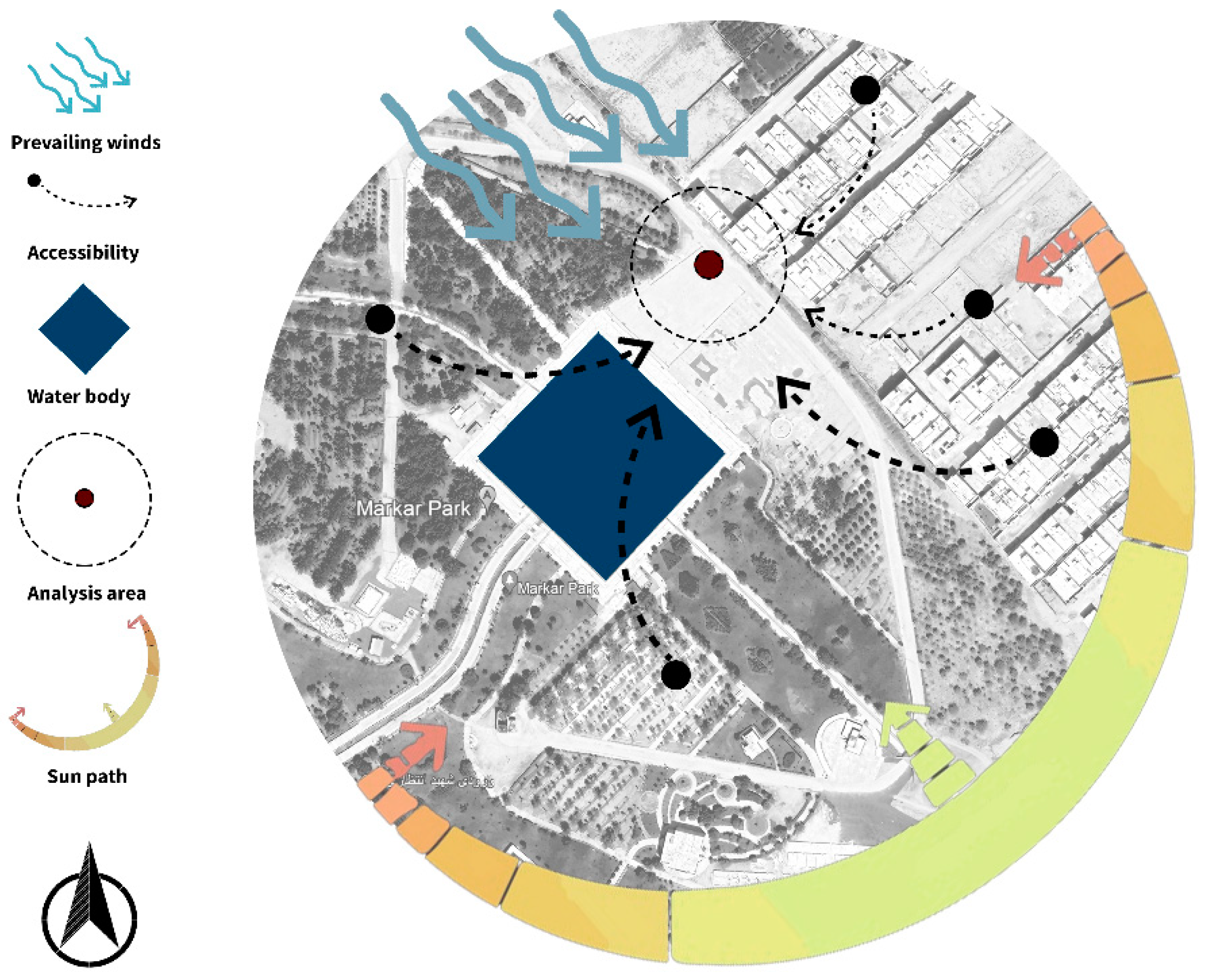
References
- IEA. CO2 Emissions in 2023; IEA: Paris, France, 2024; Available online: https://www.iea.org/reports/co2-emissions-in-2023 (accessed on 10 March 2024).
- Raven, J.; Stone, B.; Mills, G.; Towers, J.; Katzschner, L.; Leone, M.F.; Gaborit, P.; Georgescu, M.; Hariri, M.; Lee, J.; et al. Urban Planning and Urban Design. In Climate Change and Cities: Second Assessment Report of the Urban Climate Change Research Network; Cambridge University Press: Cambridge, UK, 2018; pp. 139–172. [Google Scholar] [CrossRef]
- Li, J.; Mao, Y.; Ouyang, J.; Shi, Z. A review of urban microclimate research based on CiteSpace and VOSViewer analysis. Int. J. Environ. Res. Public Health 2022, 19, 4741. [Google Scholar] [CrossRef] [PubMed]
- Ooka, R. Recent development of assessment tools for urban climate and heat-island investigation especially based on experiences in Japan. Int. J. Climatol. 2007, 27, 1919–1930. [Google Scholar] [CrossRef]
- Zhang, J.; Li, Z.; Wei, Y.; Hu, D. The impact of the building morphology on microclimate and thermal comfort-a case study in Beijing. Build. Environ. 2022, 223, 109469. [Google Scholar] [CrossRef]
- Kearney, M.R.; Shamakhy, A.; Tingley, R.; Karoly, D.J.; Hoffmann, A.A.; Briggs, P.R.; Porter, W.P. Microclimate modeling at macro scales: A test of a general microclimate model integrated with gridded continental-scale soil and weather data. Methods Ecol. Evol. 2014, 5, 273–286. [Google Scholar] [CrossRef]
- Allegrini, J.; Dorer, V.; Carmeliet, J. Influence of the urban microclimate in street canyons on the energy demand for space cooling and heating of buildings. Energy Build. 2012, 55, 823–832. [Google Scholar] [CrossRef]
- Pompei, L.; Nardecchia, F.; Gugliermetti, L.; Cinquepalmi, F. Design of three outdoor combined thermal comfort prediction models based on urban and environmental parameters. Energy Build. 2024, 306, 113946. [Google Scholar] [CrossRef]
- Nikolopoulou, M. Outdoor thermal comfort. Front. Biosci. 2011, S3, 1552. [Google Scholar] [CrossRef]
- Oke, T.R.; Mills, G.; Christen, A.; Voogt, J.A. Climates of Humans; Cambridge University Press: Cambridge, UK, 2017; pp. 385–407. [Google Scholar] [CrossRef]
- Xiao, T.; Sheng, L.; Zhang, S.; Zheng, L.; Shui, T. Thermal comfort improvement strategies for outdoor spaces in traditional villages based on ENVI-MeT: Shimengao village in Chizhou City. Sustainability 2023, 15, 11785. [Google Scholar] [CrossRef]
- American Society of Heating, Refrigerating and Air-Conditioning Engineers. ASHRAE Handbook: Fundamentals; American Society of Heating, Refrigerating and Air-Conditioning Engineers: Atlanta, GA, USA, 1989. [Google Scholar]
- Jomehzadeh, F.; Nejat, P.; Calautit, J.K.; Yusof, M.B.M.; Zaki, S.A.; Hughes, B.R.; Yazid, M.N.A.W.M. A review on windcatcher for passive cooling and natural ventilation in buildings, Part 1: Indoor air quality and thermal comfort assessment. Renew. Sustain. Energy Rev. 2017, 70, 736–756. [Google Scholar] [CrossRef]
- Ghaemmaghami, P.S.; Mahmoudi, M. Wind tower a natural cooling system in Iranian traditional architecture. In Proceedings of the International Conference Passive and Low Energy Cooling for the Built Environment, Santorini, Greece, 9–21 May 2005; pp. 71–76. [Google Scholar]
- Valipour, E.; Oshrieh, R. Survey of traditional wind catchers of the Middle East. In Proceedings of the Developing the Frontier of Sustainable Design, Engineering, and Construction 2012, Fort Worth, TX, USA, 7–9 November 2012; pp. 912–920. [Google Scholar] [CrossRef]
- Roaf, S. Air-conditioning avoidance: Lessons from the windcatchers of Iran. In Proceedings of the International Conference Passive and Low Energy Cooling for the Built Environment, Santorini, Greece, 9–21 May 2005; pp. 1053–1057. [Google Scholar]
- Ji, Z.; Su, Y.; Khan, N. Performance evaluation and energy saving potential of windcatcher natural ventilation systems in China. Int. J. Arch. Eng. Constr. 2012, 1, 84–95. [Google Scholar] [CrossRef]
- Alsailani, M.; Montazeri, H.; Rezaeiha, A. Towards optimal aerodynamic design of wind catchers: Impact of geometrical characteristics. Renew. Energy 2021, 168, 1344–1363. [Google Scholar] [CrossRef]
- Jomehzadeh, F.; Hussen, H.M.; Calautit, J.K.; Nejat, P.; Ferwati, M.S. Natural ventilation by windcatcher (Badgir): A review on the impacts of geometry, microclimate and macroclimate. Energy Build. 2020, 226, 110396. [Google Scholar] [CrossRef]
- Haghighi, A.; Pakdel, S.H.; Jafari, A. A study of a windcatcher assisted adsorption cooling channel for natural cooling of a 2-storey building. Energy 2016, 102, 118–138. [Google Scholar] [CrossRef]
- Saadatian, O.; Haw, L.C.; Sopian, K.; Sulaiman, M.A. Review of windcatcher technologies. Renew. Sustain. Energy Rev. 2012, 16, 1477–1495. [Google Scholar] [CrossRef]
- Jafarian, M.; Jaafarian, S.M.; Haseli, P.; Mohebbi, A. Performance analysis of a passive cooling system using underground channel (Naghb). Energy Build. 2010, 42, 559–562. [Google Scholar] [CrossRef]
- Erell, E.; Pearlmutter, D.; Etzion, Y. A multi-stage down-draft evaporative cool tower for semi-enclosed spaces: Aerodynamic performance. Sol. Energy 2008, 82, 420–429. [Google Scholar] [CrossRef]
- Li, L.; Mak, C.M. The assessment of the performance of a windcatcher system using computational fluid dynamics. Build. Environ. 2007, 42, 1135–1141. [Google Scholar] [CrossRef]
- Reyes, V.; Sierra, F.; Moya, S.L.; Carrillo, F. Flow field obtained by PIV technique for a scaled building-wind tower model in a wind tunnel. Energy Build. 2015, 107, 424–433. [Google Scholar] [CrossRef]
- Shorbagy, A.M.E. Design with Nature: Windcatcher as a Paradigm of Natural Ventilation Device in Buildings. Int. J. Civ. Environ. Eng. IJCEE IJENS 2012, 10, 21–26. [Google Scholar]
- Hassan, A.M.; Lee, H.; Yoo, U.-S. From medieval Cairo to modern Masdar City: Lessons learned through a comparative study. Archit. Sci. Rev. 2015, 59, 39–52. [Google Scholar] [CrossRef]
- Ecosistema Urbano. Available online: https://ecosistemaurbano.com/eco-boulevard/ (accessed on 1 July 2024).
- Soutullo, S.; Olmedo, R.P.; Sánchez, M.N.; Heras, M.R. Thermal conditioning for urban outdoor spaces through the use of evaporative wind towers. Build. Environ. 2011, 46, 2520–2528. [Google Scholar] [CrossRef]
- Soutullo, S.; Guaita, C.S.; Sánchez, M.N.; Zarzalejo, L.F.; Miranda, R.E.; Del Rosario Heras Celemín, M. Comfort evaluation in an urban boulevard by means of evaporative wind towers. Energy Procedia 2012, 30, 1226–1232. [Google Scholar] [CrossRef][Green Version]
- Montazeri, H.; Montazeri, F. CFD simulation of cross-ventilation in buildings using rooftop wind-catchers: Impact of outlet openings. Renew. Energy 2018, 118, 502–520. [Google Scholar] [CrossRef]
- Zaki, A.; Richards, P.J.; Sharma, R.N. Analysis of airflow inside a two-sided wind catcher building. J. Wind. Eng. Ind. Aerodyn. 2019, 190, 71–82. [Google Scholar] [CrossRef]
- Rup, K.; Sarna, P. Analysis of turbulent flow through a square-sectioned duct with installed 90-degree elbow. Flow Meas. Instrum. 2011, 22, 383–391. [Google Scholar] [CrossRef]
- Chew, L.W.; Nazarian, N.; Norford, L.K. Pedestrian-Level Urban Wind Flow Enhancement with Wind Catchers. Atmosphere 2017, 8, 159. [Google Scholar] [CrossRef]
- Palusci, O.; Cecere, C. Urban Ventilation in the Compact City: A Critical review and a Multidisciplinary Methodology for improving Sustainability and Resilience in Urban areas. Sustainability 2022, 14, 3948. [Google Scholar] [CrossRef]
- Oke, T.R. The distinction between canopy and boundary-layer urban heat islands. Atmosphere 1976, 14, 268–277. [Google Scholar] [CrossRef]
- Blocken, B.B.; Carmeliet, J.J. Pedestrian Wind Environment around Buildings: Literature Review and Practical Examples. J. Therm. Envel. Build. Sci. 2004, 28, 107–159. [Google Scholar] [CrossRef]
- Nejat, P.; Calautit, J.K.; Fekri, Y.; Sheikhshahrokhdehkordi, M.; Alsaad, H.; Voelker, C. Influence of terrain and atmospheric boundary layer on the ventilation and thermal comfort performance of windcatchers. J. Build. Eng. 2023, 73, 106791. [Google Scholar] [CrossRef]
- Nikolopoulou, M.; Lykoudis, S. Use of outdoor spaces and microclimate in a Mediterranean urban area. Build. Environ. 2007, 42, 3691–3707. [Google Scholar] [CrossRef]
- National Weather Service. Available online: https://www.weather.gov/ddc/windchillddc#:~:text=Wind%20Chill%20Calculator&text=Wind%20chill%20temperature%20is%20a,temperature%20(which%20can%20kill) (accessed on 1 June 2024).
- Givoni, B. Indoor temperature reduction by passive cooling systems. Sol. Energy 2011, 85, 1692–1726. [Google Scholar] [CrossRef]
- Roghanchi, P.; Kocsis, K.C.; Sunkpal, M. Sensitivity analysis of the effect of airflow velocity on the thermal comfort in underground mines. J. Sustain. Min. 2016, 15, 175–180. [Google Scholar] [CrossRef]
- Mostafaeipour, A.; Bardel, B.; Mohammadi, K.; Sedaghat, A.; Dinpashoh, Y. Economic evaluation for cooling and ventilation of medicine storage warehouses utilizing wind catchers. Renew. Sustain. Energy Rev. 2014, 38, 12–19. [Google Scholar] [CrossRef]
- Afshin, M.; Sohankar, A.; Manshadi, M.D.; Daneshgar, M.R.; Kamaragi, G.R.D. Visualized Flow Patterns around and inside a Two-Sided Wind-Catcher in the Presence of Upstream Structures. Int. J. Energy Power Eng. 2014, 8, 1312–1317. [Google Scholar] [CrossRef]
- Montazeri, H.; Azizian, R. Experimental study on natural ventilation performance of one-sided wind catcher. Build. Environ. 2008, 43, 2193–2202. [Google Scholar] [CrossRef]
- Hosseini, S.H.; Shokry, E.; Hosseini, A.J.A.; Ahmadi, G.; Calautit, J.K. Evaluation of airflow and thermal comfort in buildings ventilated with wind catchers: Simulation of conditions in Yazd City, Iran. Energy Sustain. Dev. 2016, 35, 7–24. [Google Scholar] [CrossRef]
- Alwetaishi, M.; Gadi, M.B. New and innovative wind catcher designs to improve indoor air quality in buildings. Energy Built Environ. 2021, 2, 337–344. [Google Scholar] [CrossRef]
- Esfeh, M.K.; Dehghan, A.A.; Manshadi, M.D.; Mohagheghian, S. Visualized flow structure around and inside of one-sided wind-catchers. Energy Build. 2012, 55, 545–552. [Google Scholar] [CrossRef]
- Dehghan, A.A.; Esfeh, M.K.; Manshadi, M.D. Natural ventilation characteristics of one-sided wind catchers: Experimental and analytical evaluation. Energy Build. 2013, 61, 366–377. [Google Scholar] [CrossRef]
- National Weather Service. Available online: https://www.weather.gov/safety/cold-wind-chill-chart (accessed on 1 June 2024).
- Shih, T.; Liou, W.W.; Shabbir, A.; Yang, Z.; Zhu, J. A New K-Epsilon Eddy Viscosity Model for High Reynolds Number Turbulent Flows: Model Development and Validation; NASA Technical Report Server: Washington, DC, USA, 1994; Volume 95, p. 11442.
- Roudsari, M.S.; Pak, M.; Viola, A. Ladybug: A parametric environmental plugin for Grasshopper to help designers create an environmentally-conscious design. In Proceedings of the Building Simulation 2013: 13th Conference of IBPSA, Chambery, France, 26–28 August 2013; pp. 3128–3135. [Google Scholar] [CrossRef]
- Energy Plus. Available online: https://energyplus.net/ (accessed on 28 May 2024).
- National Weather Service. Available online: https://www.weather.gov/pqr/wind (accessed on 28 May 2024).
- Google Earth Pro, Yazd, Iran. Available online: https://www.google.com/maps/place/31%C2%B052’43.0%22N+54%C2%B023’54.0%22E/@31.8785898,54.3969853,565m/data=!3m1!1e3!4m4!3m3!8m2!3d31.8786111!4d54.3983333?entry=ttu&g_ep=EgoyMDI0MTEyNC4xIKXMDSoASAFQAw%3D%3D(31°52’43”N 54°23’54”E) (accessed on 26 November 2024).
- Eurocode Tools. Available online: https://eurocodes-tools.com/en/roughness-factor-crz (accessed on 15 February 2024).
- Pearlmutter, D.; Erell, E.; Etzion, Y.; Meir, I.A.; Di, H. Refining the use of evaporation in an experimental down-draft cool tower. Energy Build. 1996, 23, 191–197. [Google Scholar] [CrossRef]
- Benkari, N.; Fazil, I.; Husain, A. Design and performance comparison of two patterns of wind-catcher for a semi-enclosed courtyard. Int. J. Mech. Eng. Robot. Res. 2017, 6, 396–400. [Google Scholar] [CrossRef]


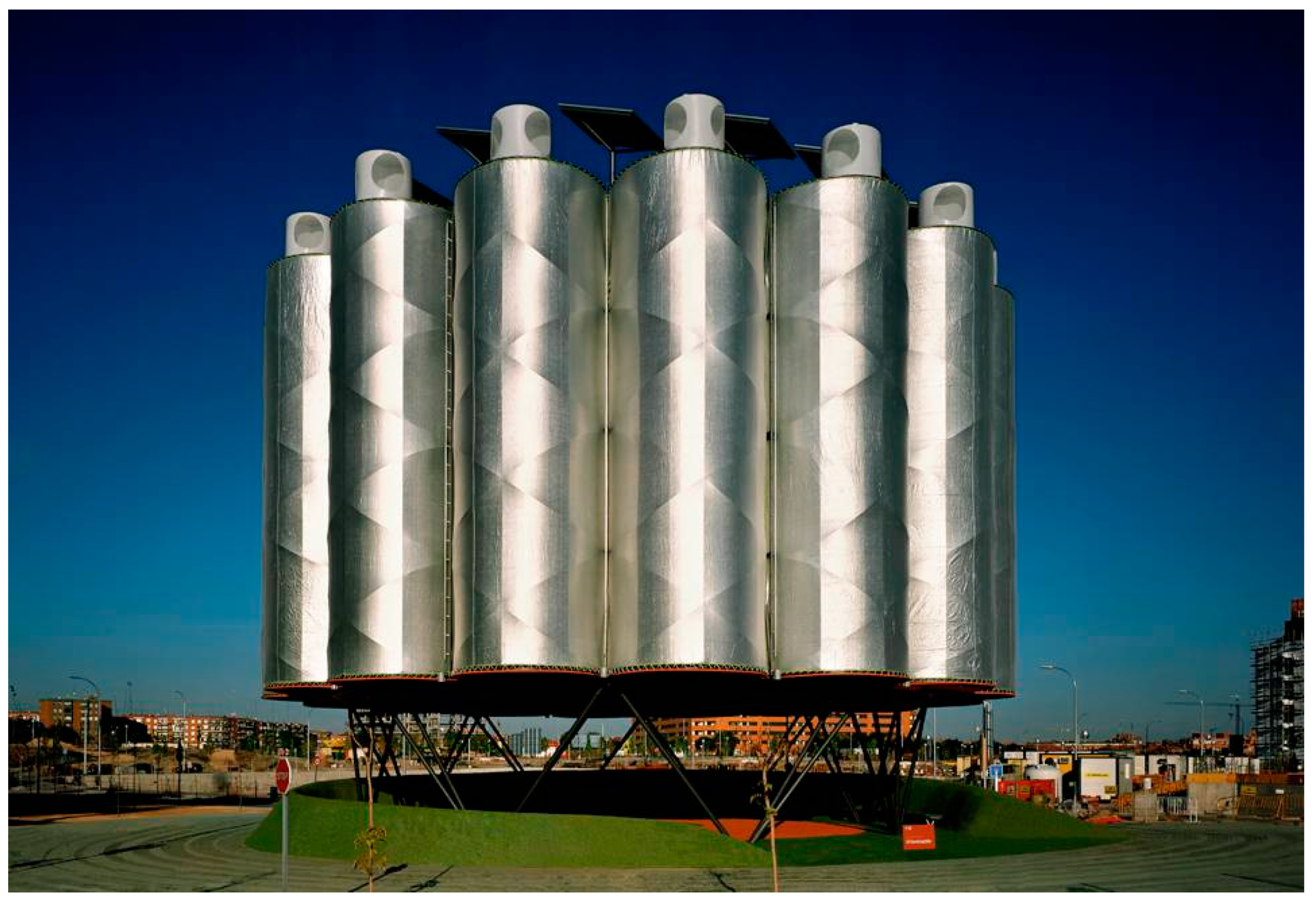

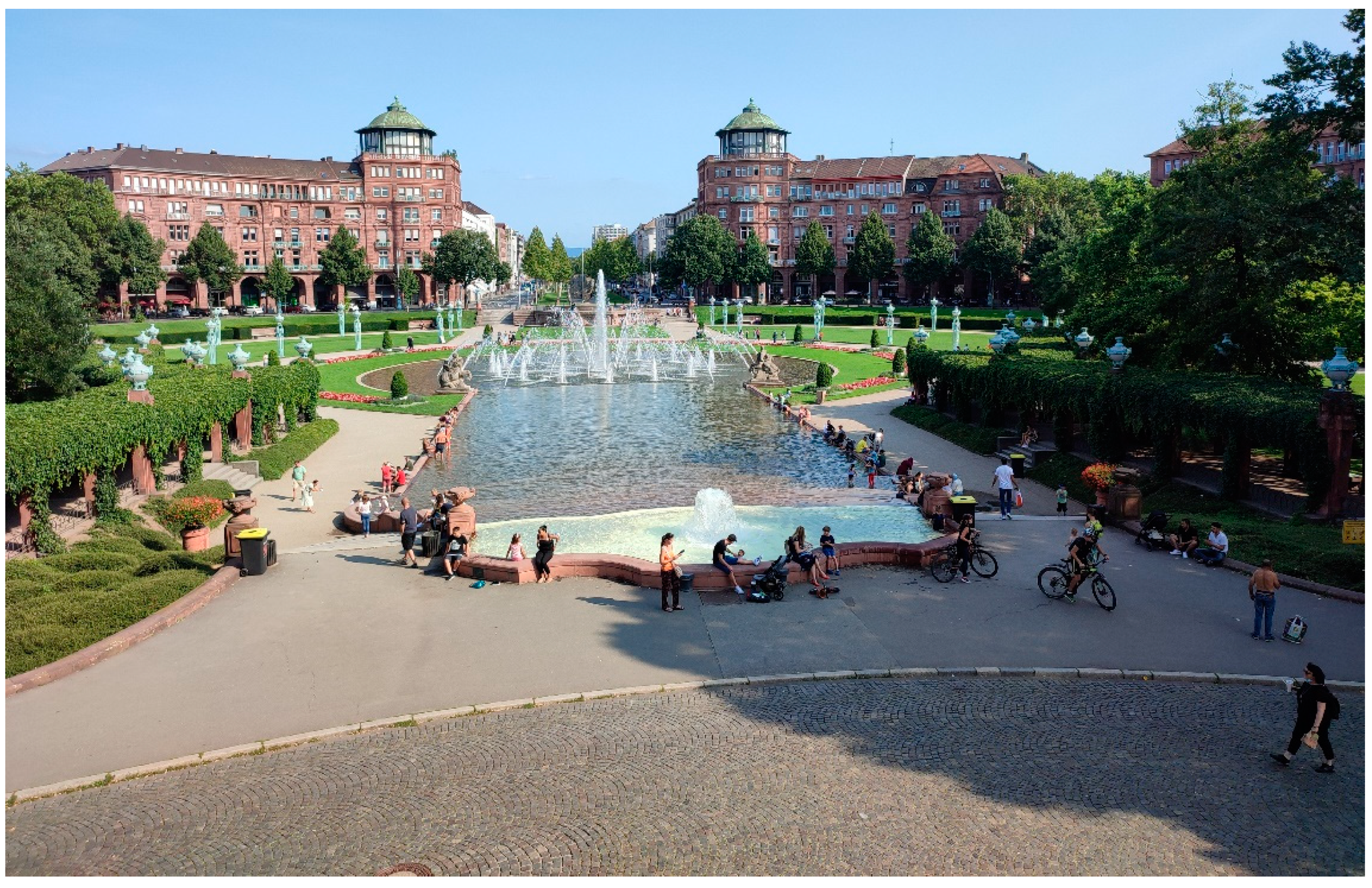
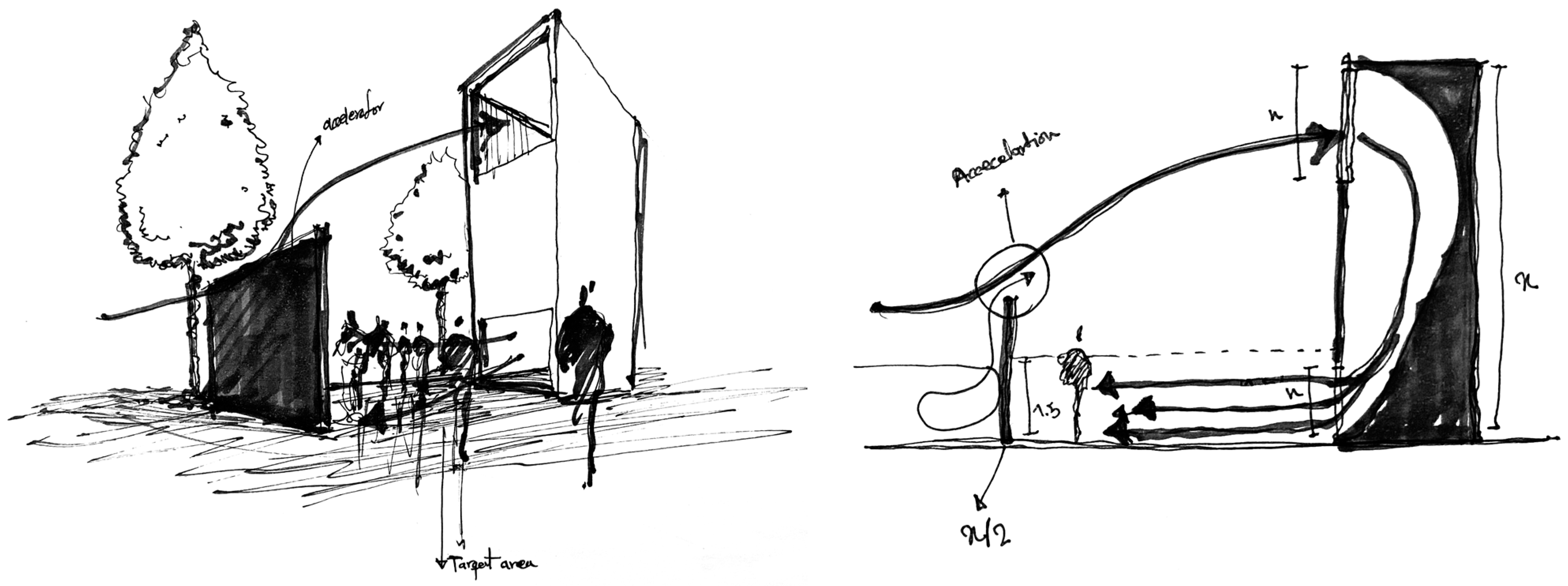
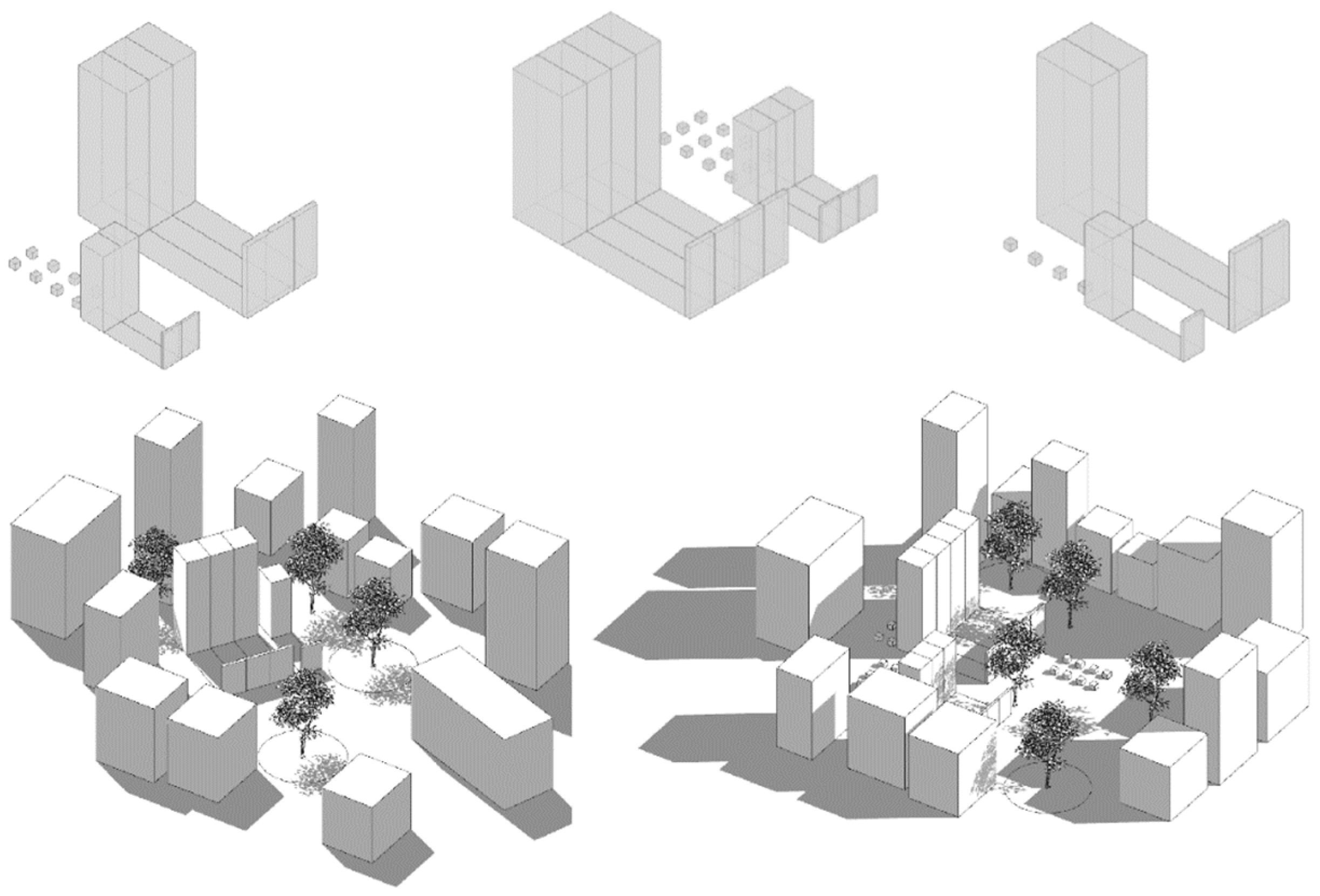

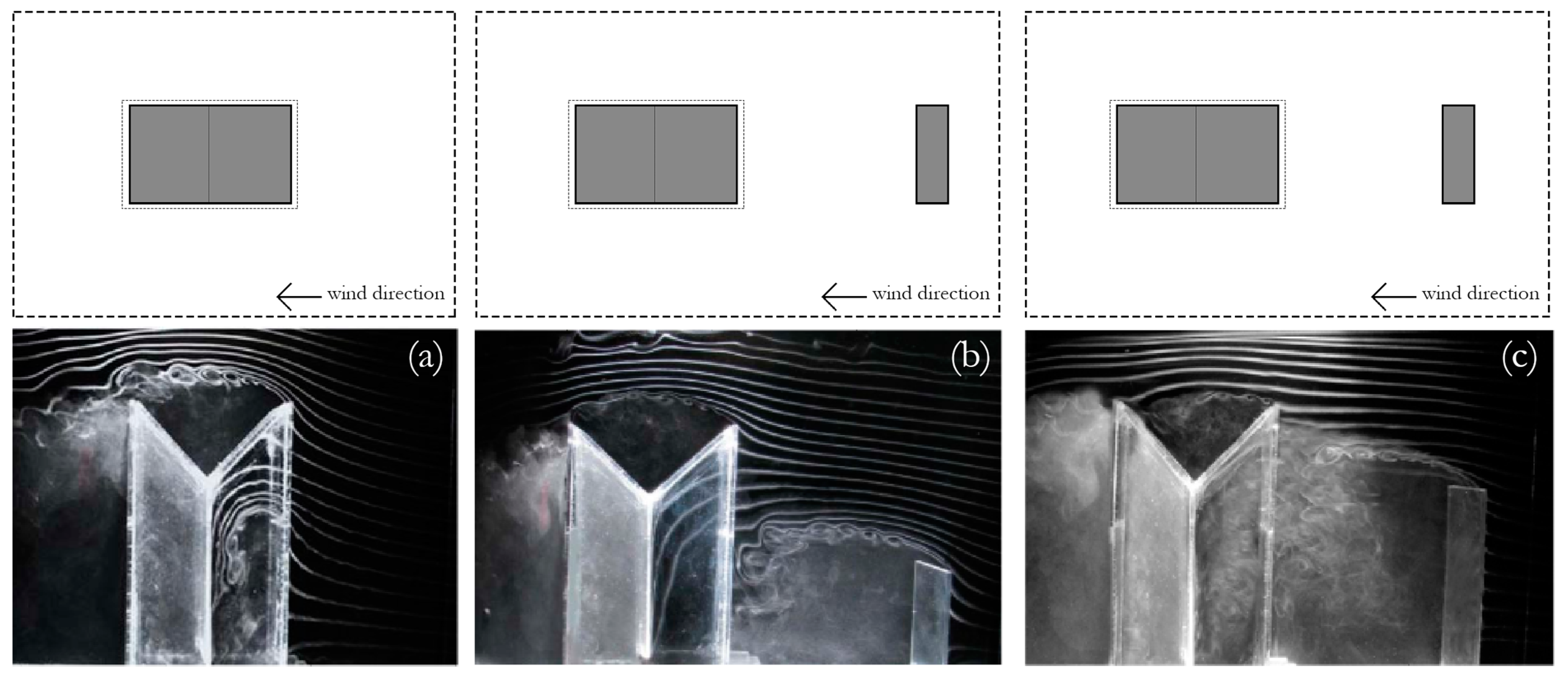
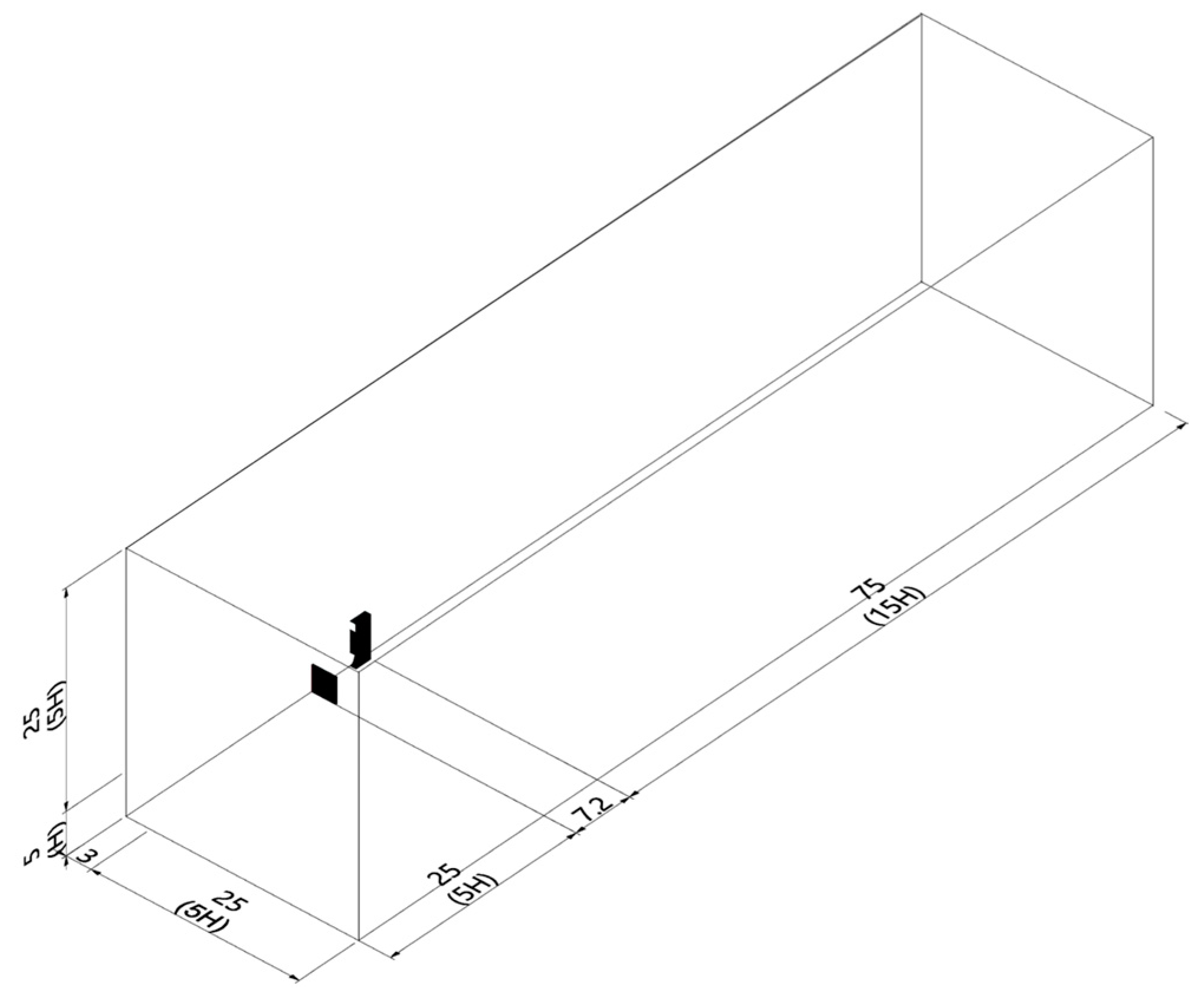
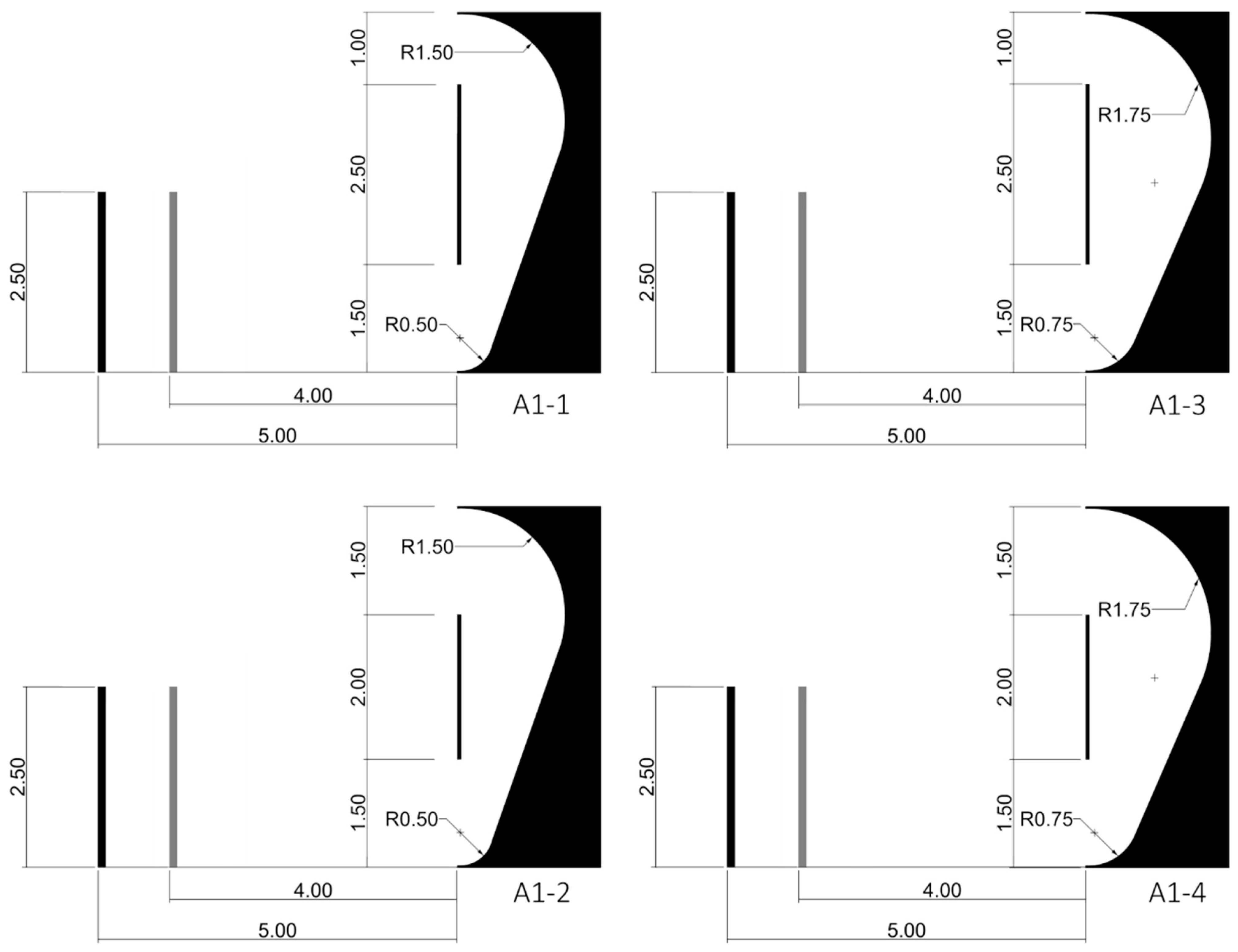

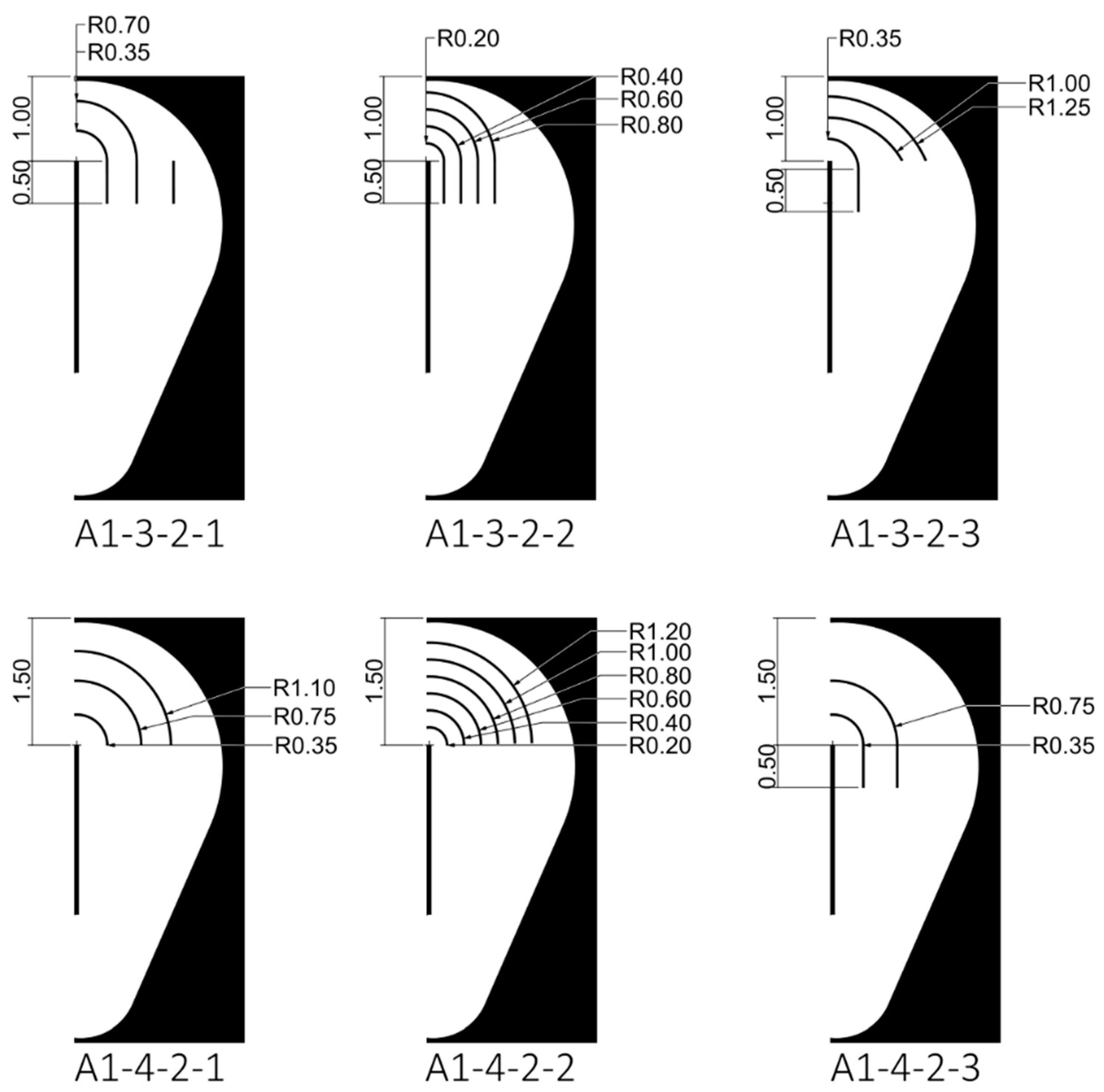
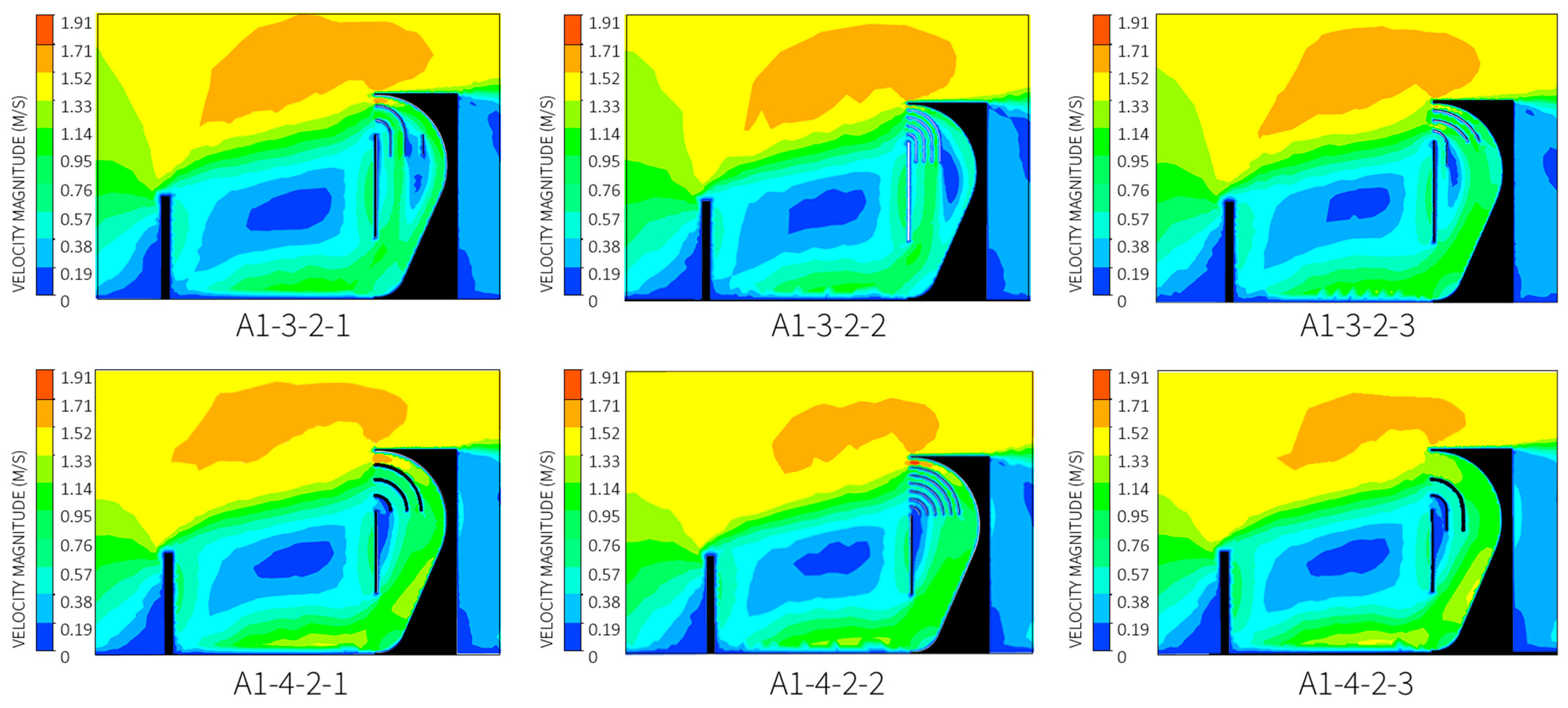
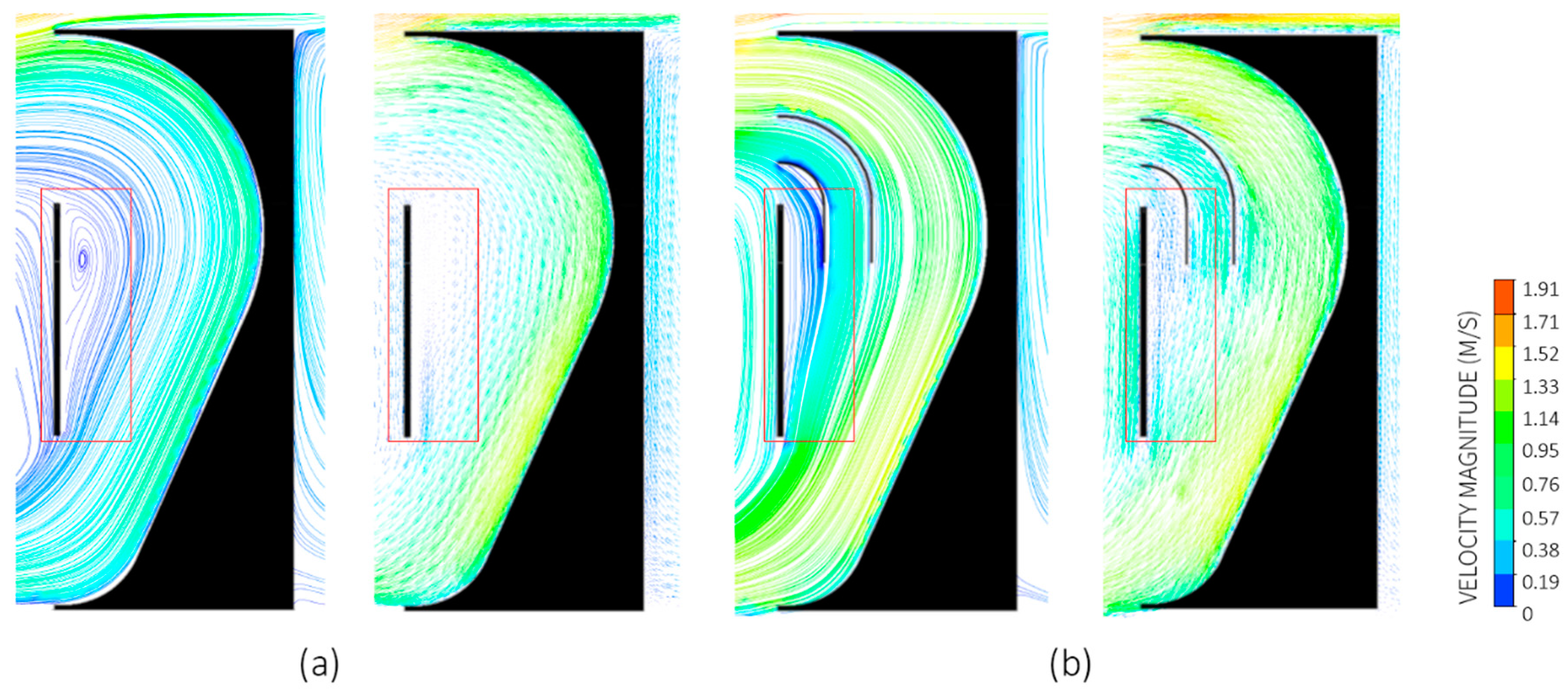
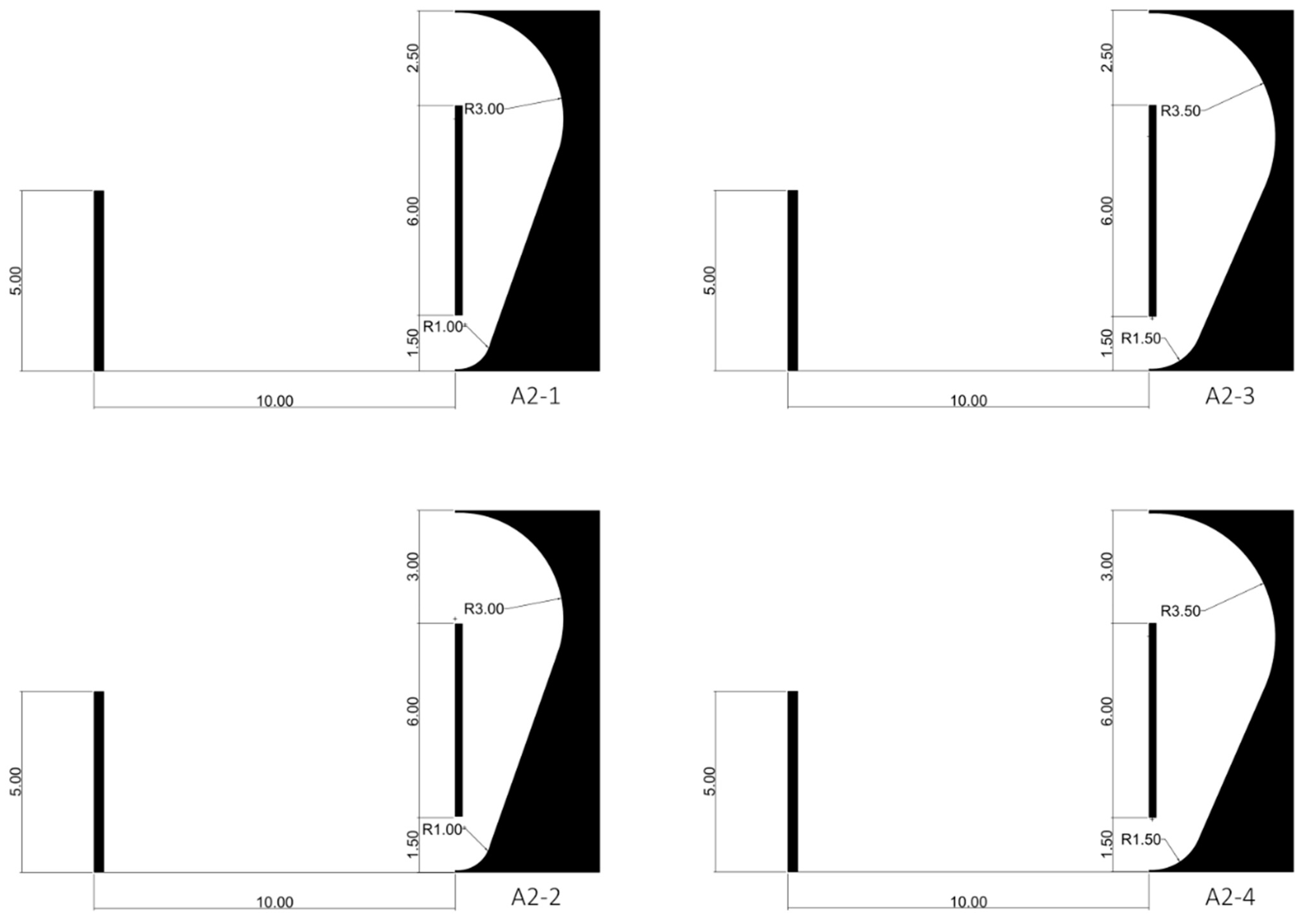



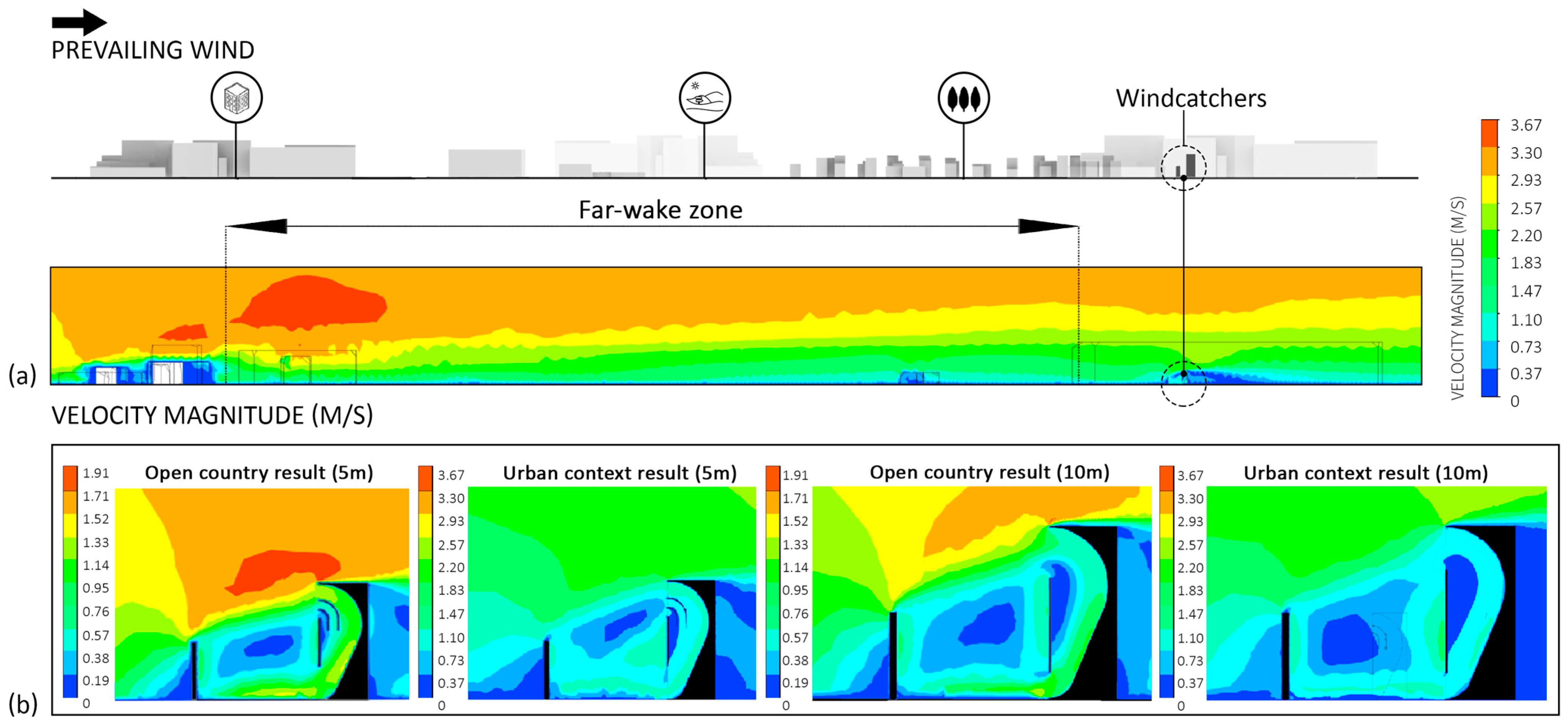
| Near-wall treatment | Standard wall functions |
| Turbulence model | Realizable k-ε |
| Discretization | Second-order |
| Pressure interpolation | Second-order |
| Pressure–velocity coupling | Simple |
| Pressure outlet | Static, gage, value = 0 |
Disclaimer/Publisher’s Note: The statements, opinions and data contained in all publications are solely those of the individual author(s) and contributor(s) and not of MDPI and/or the editor(s). MDPI and/or the editor(s) disclaim responsibility for any injury to people or property resulting from any ideas, methods, instructions or products referred to in the content. |
© 2024 by the authors. Licensee MDPI, Basel, Switzerland. This article is an open access article distributed under the terms and conditions of the Creative Commons Attribution (CC BY) license (https://creativecommons.org/licenses/by/4.0/).
Share and Cite
Ghandi, H.; Leone, M.F. The Potential of One-Sided Traditional Windcatchers for Outdoor Use as a Sustainable Urban Feature. Urban Sci. 2024, 8, 229. https://doi.org/10.3390/urbansci8040229
Ghandi H, Leone MF. The Potential of One-Sided Traditional Windcatchers for Outdoor Use as a Sustainable Urban Feature. Urban Science. 2024; 8(4):229. https://doi.org/10.3390/urbansci8040229
Chicago/Turabian StyleGhandi, Hossein, and Mattia Federico Leone. 2024. "The Potential of One-Sided Traditional Windcatchers for Outdoor Use as a Sustainable Urban Feature" Urban Science 8, no. 4: 229. https://doi.org/10.3390/urbansci8040229
APA StyleGhandi, H., & Leone, M. F. (2024). The Potential of One-Sided Traditional Windcatchers for Outdoor Use as a Sustainable Urban Feature. Urban Science, 8(4), 229. https://doi.org/10.3390/urbansci8040229








